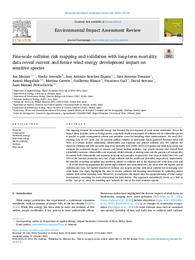Título :
Fine-scale collision risk mapping and validation with long-term mortality data reveal current and future wind energy development impact on sensitive species |
Autor :
Morant, Jon 
Arrondo, Eneko
Sánchez Zapata, José Antonio 
Donázar, José Antonio 
Margalida, Antoni
Carrete, Martina
Blanco, Guillermo
Guil, Francisco 
Serrano Lozano, David 
Pérez-García, Juan Manuel |
Editor :
Elsevier |
Departamento:
Departamentos de la UMH::Biología Aplicada |
Fecha de publicación:
2023-10-27 |
URI :
https://hdl.handle.net/11000/31177 |
Resumen :
The ongoing demand for renewable energy has boosted the development of wind farms worldwide. Given the
impact these facilities have on flying species, a spatially explicit assessment of collision risk in vulnerable species
is needed to guide management actions and prioritise areas for installing these infrastructures. We used GPStracking
data of 127 adult and 50 juvenile griffon vultures in peninsular Spain gathered between 2014 and
2022 to evaluate factors influencing vulnerability and exposure and predict collision risk. We validate the
observed collision risk with recorded long-term mortality data (1999–2022) at regional and wind farm scales and
evaluate the estimated impact of current and future turbine facilities. Our results showed that overall food
availability increases vulnerability and exposure, whilst distance to nesting areas and the presence of conspecifics
decreased both vulnerability and exposure in adults and juveniles, respectively. Our maps revealed that 19% and
10% of the Spanish peninsular area had a high collision risk for adults and juveniles, respectively. Importantly,
the number of turbine casualties was positively related to collision risk at the regional and wind farm scale and
~ 18 of the breeding population lies within high collision risk areas.Moreover, the areas with the highest risk of
collision also have the highest number of turbines and largely overlap with areas suitable for developing new
wind farms. Our study highlights the need to reduce collision risk mapping uncertainties by validating model
outputs with actual mortality data. Moreover, it emphasises the urgent need for spatial planning of wind energy
development, searching for safer alternatives for biodiversity. This approach undoubtedly serves as a tool to
define “not go to” areas for installing new turbines for one of the most sensitive species.
|
Palabras clave/Materias:
conservation
movement ecology
renewable energy
spatial planning
turbines
wind farms |
Área de conocimiento :
CDU: Ciencias puras y naturales: Biología: Ecología general y biodiversidad |
Tipo de documento :
info:eu-repo/semantics/article |
Derechos de acceso:
info:eu-repo/semantics/openAccess
Attribution-NonCommercial-NoDerivatives 4.0 Internacional |
DOI :
https://doi.org/10.1016/j.eiar.2023.107339 |
Publicado en:
Environmental Impact Assessment Review 104 (2024) |
Aparece en las colecciones:
Artículos - Biología Aplicada
|
 La licencia se describe como: Atribución-NonComercial-NoDerivada 4.0 Internacional.
La licencia se describe como: Atribución-NonComercial-NoDerivada 4.0 Internacional.
.png)
